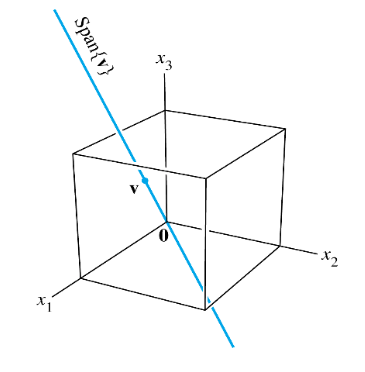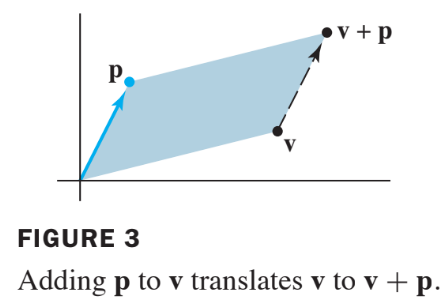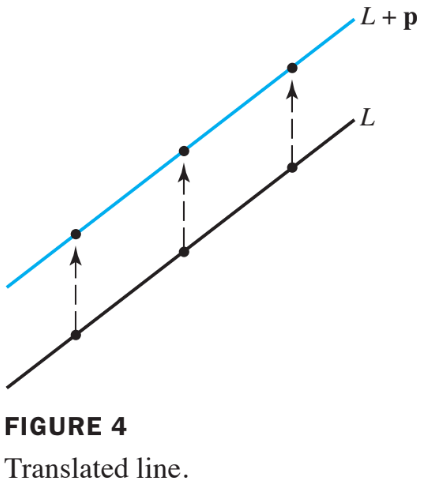Linear Equations in Linear Algebra
1.5 Solution Sets of Linear Systems
- Solution sets of linear systems are important objects of study in linear algebra.
- This section uses vector notation to give explicit and geometric descriptions of such solution set.
Homogeneous Linear Systems
A system of linear equations is said to be homogeneous if it can be written in the form where is an matrix and is the zero vector in .
Such a system always has at least one solution, namely, (the zero veoctor in ).
This zero solution is usually called the trivial solution.
For a given homogeneous equation , the important question is whether there exists a nontrivial solution, that is, a nonzero vector that satisfies .
The Existence and Unqueness Theorem in Section 1.2 (Theorem) leads immediately to the following fact.
The homogeneous equation has a nontrivial solution if and only if the equation has at least one free variable.
Example 1:
Determine if the following homogeneous system has a nontrivial solution. Then describe the solution set.
Solution of Example 1
Let be the matrix of coefficients of the system and row reduce the augmented matrix to echelon form:
Since is a free variable, has nontrivial solutions (one for each choice of .)
Continue the row reduction of to reduced echelon form:
Solve for the basic variables and to obtain , with free.
As a vector, the general solution of has the form given below.
where
Here is factored out of the expression for the general solution vector.
This shows that every solution of in this case is a scalar multiple of .
The trivial solution is obtained by choosing
Geometrically, the solution set is a line through in .
See Fig.1 below.

Parametric Vector Form
The equation of the form ( in ) is called a parametric vector equation of the plane.
In Example 1, the equation (with free), or (with in ), is a parametric vector equation of a line.
Whenever a solution set is described explicitly with vectors as in Example 1, we say that the solution is in parametric vector form.
Solutions of Nonhomogeneous Systems
When a nonhomogeneous linear system has many solutions, the general solution can be written in parametric vector form as one vector plus an arbitrary linear combination of vectors that satisfy the corresponding homogeneous system.
Example 3
Describe all solutions of where
Solution of Example 3
Row operations on produce
Thus, , and is free.
As a vector, the general solution of has the form

The equation , or, writing t as a general parameter,
describes the solution set of in parametric vector form.
The solution set of has the parametric vector equation
[with the same that appears in (3)].
Thus the solutions of are obtained by adding the vector to the solutions of .
The vector itself is just one particular solution of [corresponding to = 0 in (3).]
To describe the solution of geometrically, we can think of vector addition as a translation.
Given and in or , the effect of adding to is to move in a direction parallel to the line through and .
We say that is translated by to . See the following figure.

If each point on a line in or is translated by a vector , the result is a line parallel to . See the following figure.

Suppose is the line through and , described by equation (4).
Adding to each point on produces the translated line described by equation (3).
We call (3) the equation of the line through parallel to .
Thus the solution set of is a line through parallel to the solution set of . The figure below illustrates this case.

The relation between the solution sets of and shown in the figure above generalizes to any consistent equation ,although the solution set will be larger than a line when there are several free variables.
Theorem 6
Suppose the equation is consistent for some given , and let be a solution (,it means that is a particular solution).
Then the solution set of is the set of all vectors of the form , where is any solution of the homogeneous equation .
- Theorem 6 says that if has a solution, then the solution set is obtained by translating the solution set of using any particular solution of for the translation.
Writing a Solution Set (of a Consistent System) in Parametric Vector Form
- Row reduce the augmented matrix to reduced echelon form, RREF.
- Express each basic variable in terms of any free variables appearing in an equation.
- Write a typical solution as a vector whose entries depend on the free variables, if any.
- Decompose into a linear combination of vectors (with numeric entries) using the free variables as parameters.